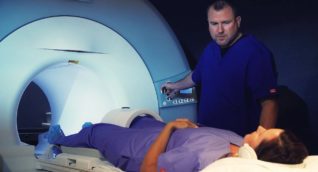Verteboplasty stabilizes broken bones in the spine caused by osteoporosis. Vertebroplasty is a minimally invasive procedure. Under fluoroscopy for guidance, a needle is inserted into the crushed vertebrae. A surgical bone cement called polymethylmethacrylate is injected in the bone to stabilize it. Often, more than one crushed vertebrae can be treated in a single procedure.
These procedures take about one hour for each vertebra involved. Patients are observed closely in the recovery room immediately following the procedure. These are outpatient procedures and most patients are discharged the same day. Patients should not drive until they are given approval by their doctor. Patients need to arrange for transportation home from the hospital.
Pain relief will be immediate for some patients. In others, elimination or reduction of pain is reported within two days. At home, patients can return to their normal daily activities, although strenuous exertion, such as heavy lifting, should be avoided for at least six weeks.
Patients should see their primary care physician to begin or review their treatment plan for osteoporosis, including medications to prevent further bone loss.
These procedures have been studied extensively, and the results are quite compelling. Studies report:
• Significant reduction in back pain
• Significant improvement in quality of life
• Significant reduction in number of days per month that a patient remains in bed
• Significant improvement in mobility
• Improved ability to perform activities of daily living
• Significant reduction in number of days where pain interfered with daily activities.
Any type of surgery involves risk; however, the serious complication rate associated with these procedures is very low, on the order of 1%. Patients are encouraged to discuss these and other risks with their primary care physician or one of ARA’s neurointerventional surgeons. Medicare and most insurance carriers cover these procedures.
Vertebroplasty – Using fluoroscopy for guidance, a needle is inserted into the crushed vertebra and bone cement is injected to stabilize it. Several vertebrae can be treated during one procedure.
Kyphoplasty – Small balloons gently elevate the collapsed vertebra or sacrum. The balloons are deflated and the created cavity is filled with bone cement that forms an internal cast and stabilizes the fracture.
Treatment after removal of spinal tumors – Vertebroplasty can be performed on vertebrae after the removal of spinal tumors by ablation or other techniques. The injection of bone cement into the cavity can restore mobility and relieve pain.
SpineJack device – This innovative technology is essentially a tiny jack that is inserted into a collapsed vertebra and elevated to increase vertebral height. It remains in the vertebra and bone cement is filled around it for stabilization.

 Back to Top
Back to Top